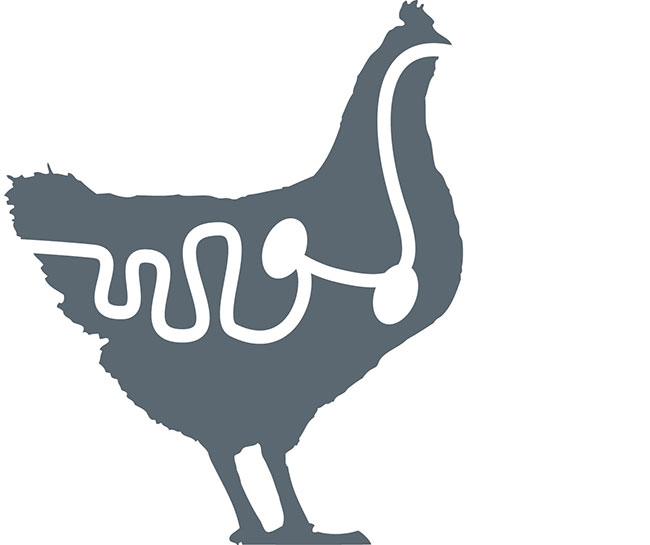
What’s going on in the gut?
By Jane Robinson
Features HealthModelling helps study microbiome to improve poultry health.
 Researchers have been focused on finding ways to create a healthy gut microbiome to support overall bird health. Photo: Alltech Canada
Researchers have been focused on finding ways to create a healthy gut microbiome to support overall bird health. Photo: Alltech Canada One of the biggest questions facing the Canadian poultry industry is how to maintain bird health with less reliance on antibiotics. University of Guelph’s Dr. Shayan Sharif is looking for solutions from a number of different angles with a diverse team of researchers from across Canada.
It’s not a simple, straightforward task. “The challenge to reduce our reliance on antibiotics while maintaining poultry health is a multifaceted one, and it requires a multi-pronged approach,” says Sharif, Professor and Associate Dean of Research and Graduate Studies, Ontario Veterinary College. That bigger picture view included reaching beyond the poultry researcher realm to partner with Dr. John Parkinson, a senior scientist at Sick Kids Hospital in Toronto. “John is a world-renowned expert in studying intestinal microbial communities, and he brings an incredible knowledge and experience through his research on human intestinal microbes,” says Sharif.
Parkinson is focused on two main areas related to creating a healthy gut microbiome to support overall bird health. He’s been testing a number of dietary additives in broiler feeding trials to study the impact on bird health. And he’s developed a computer model to better understand how different gut bacteria interact and the consequences to the bird.
Parkinson has a long-standing interest in infectious disease, and more recently became interested in the impact of pathogens on gut health by studying the microbiome, or bacterial community, in the gut. Through the course of his work he realized much can be learned about the human microbiome from other species, including mice and poultry, which eventually led him to connect with Sharif on this research.
Feeding the community
Working in collaboration with animal nutrition manufacturer Lallemand, Parkinson and Sharif are interested in studying how additives including prebiotics and probiotics alter the bacterial community, and which ones help birds establish a healthy gut microbiome early in the chick’s life.
In these studies, probiotic additives are being monitored to measure the impact on bird health, specifically the bird’s boosted ability to withstand infections from pathogens including Clostridium perfringens – the primary pathogen causing necrotic enteritis, as well as the food safety pathogens, salmonella and campylobacter. “Improving the microbiome and overall bird health will also improve food safety down the value chain by reducing the occurrence of pathogens of concern,” says Parkinson.
Parkinson and Sharif are not just focused on revealing how additives change the gut community, they are also applying cutting edge methods to understand what the consequences of these changes are. “Traditionally, studies of the microbiome have looked at what types of bacteria are present. What we are more interested in is what they are actually doing,” says Parkinson.
Parkinson’s group is currently analysing data from a trial performed with Dr. Doug Korver at the University of Edmonton to study the functional consequences of probiotics provided by Lallemand.
From the positive findings about the promising role of antibiotic alternatives in promoting gut health and bird health, Parkinson imagines a time when feed additive recommendations could be customized on a barn by barn basis, based on the gut health status of birds and makeup of the bacterial community in the microbiome. “I know that when we talk about a new product for widespread use on farms, we need to be sure the economics make sense, so we are very aware that cost-effective solutions are paramount,” says Parkinson.
The findings from this research will have direct implications for broilers and layers, and some of the strategies they develop may also apply to turkeys, according to Sharif.
Modelling the impact on gut health
The second part of Parkinson’s project benefits from his previous work in computer modelling the microbial community to predict the effect of additives on gut health.
He created a computer model that pulls in layers of data and information – including the feed trial results – to predict the impact of particular additives on gut and bird health. “We already know which bacteria are in the chicken microbiome,” says Parkinson. “And with the feeding trial data, we are able to put these pieces together to predict the outcomes of various feed ingredients.”
One of the main ways to measure the impact of additives on bird health is to determine the metabolites produced in the gut from the addition of prebiotics or probiotics to the diet. “We are most interested in the ability of certain feed additives to produce short chain fatty acids that are known to promote a healthier chicken gut,” says Parkinson. “So, when we alter things like prebiotics or probiotics, the model shows how these alter gut health and the bird’s ability to fight infection from pathogens like clostridium, salmonella and campylobacter.”
Barn-testing the model
With the computer modeling up and running, Parkinson will now work with Sharif to see how the model works outside the lab. “We’ve been predicting the effect of additives on the bacterial community in the microbiome, and now we want to test those predictions on live birds,” says Parkinson.
They’ve identified additives that, in theory, alter the microbiome of the chicken and produce more short chain fatty acids in the gut.
Next up are feeding experiments with broilers at the University of Guelph over the next few months to see if the models work in real life.
When that work is complete, Parkinson and Sharif will collaborate on another project to start developing a new probiotic product to support the microbiome and better bird health.
“We hope this microbiome work will bring safe and efficacious antibiotic alternatives to the Canadian poultry industry to improve gut health, and also improve the quality and safety of poultry products for Canadian consumers,” says Sharif.
Prebiotics vs. probiotics
Prebiotics are metabolites such as insoluble fibre or oligosaccharides that can be added to the diet. While prebiotics are fed to chickens, they are designed to “feed” the bacteria in the gut (microbiome). Chickens can’t make nutritional use of prebiotics.
Probiotics are living organisms and can consist of single strain bacteria (Lactobacillus) or a community of bacteria. Some probiotics are actually cultured from chicken caecal material, freeze dried and used in chick diets. Probiotics work by adding good bacteria to the chicken gut to produce a better overall community of beneficial bacteria in the microbiome.
This research is funded by the Canadian Poultry Research Council as part of the Poultry Science Cluster which is supported by Agriculture and Agri-Food Canada as part of the Canadian Agricultural Partnership, a federal-provincial-territorial initiative. Additional funding was received from the Ontario Ministry of Agriculture, Food and Rural Affairs, George Weston Seeding Food Innovation, Alberta Agriculture Funding Consortium, Lallemand Inc. and Compute Canada.
Print this page

